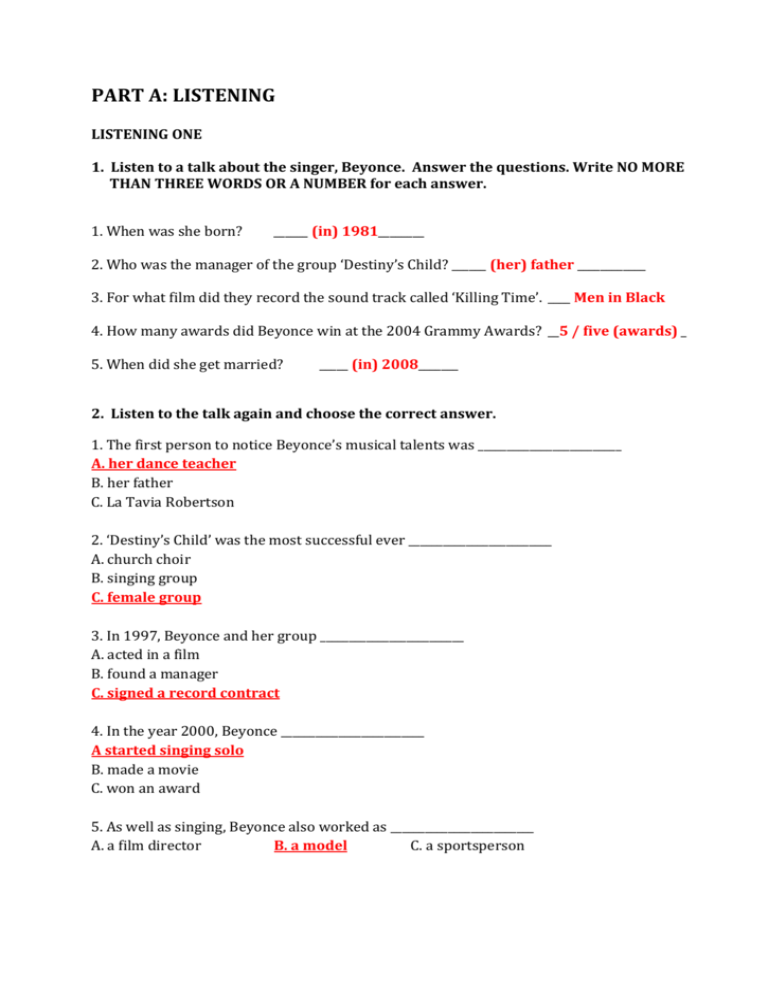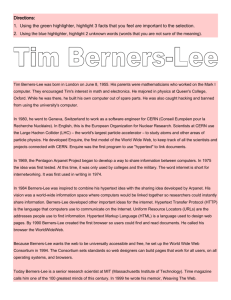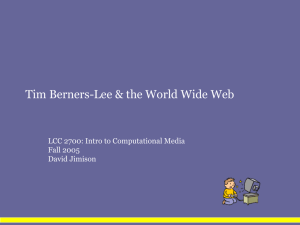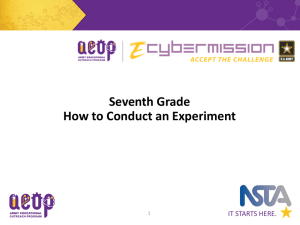part a: listening
advertisement

PART A: LISTENING LISTENING ONE 1. Listen to a talk about the singer, Beyonce. Answer the questions. Write NO MORE THAN THREE WORDS OR A NUMBER for each answer. 1. When was she born? ______ (in) 1981________ 2. Who was the manager of the group ‘Destiny’s Child? ______ (her) father ____________ 3. For what film did they record the sound track called ‘Killing Time’. ____ Men in Black 4. How many awards did Beyonce win at the 2004 Grammy Awards? __5 / five (awards) _ 5. When did she get married? _____ (in) 2008_______ 2. Listen to the talk again and choose the correct answer. 1. The first person to notice Beyonce’s musical talents was _________________________ A. her dance teacher B. her father C. La Tavia Robertson 2. ‘Destiny’s Child’ was the most successful ever _________________________ A. church choir B. singing group C. female group 3. In 1997, Beyonce and her group _________________________ A. acted in a film B. found a manager C. signed a record contract 4. In the year 2000, Beyonce _________________________ A started singing solo B. made a movie C. won an award 5. As well as singing, Beyonce also worked as _________________________ A. a film director B. a model C. a sportsperson LISTENING TWO 3. Listen to an interview with a woman, Elizabeth Sanger, about her online neighbourhood. Write True or False. 1. The online neighbourhood prevents the neighbours from getting to know each other. FALSE 2. The online neighbourhood started a long time ago. FALSE 3. The new person met everyone face-to-face before making contact online. TRUE 4. The main method of communication in the online neighbourhood is email. TRUE 5. Everyone visits the neighbourhood chat room every day. FALSE 6. The online neighbourhood has many disadvantages. FALSE 4. Listen again and complete the summary by putting in the missing words. Write NO MORE THAN ONE WORD for each answer. A new person moved into the neighbourhood. She got everyone’s names, phone numbers and 1. email addresses. She made a 2.list of these details and sent it to all the neighbours so now they can communicate online. They use the neighbourhood chat group for several purposes. For example, one neighbour found someone to fix her 3.car. Also, some neighbours collected money to get some 4.trees in their street. People do not visit their neighbours because they don’t have enough 5.time, but they can email each other any time at work or at 6.home. PART B: READING 5. Read the following text and choose the correct answer. Who Invented World Wide Web? Tim-Berners Lee is not a household name like Bill Gates. He is not outrageously rich or famous. He could have been, but he didn’t want to be. Tim-Berners Lee is a quiet man who does not like the spotlight. He is the man who invented the World Wide Web and revolutionized the Internet. Berners-Lee's invention permits anyone with a computer to easily access a vast amount of information on any subject. This is a great contribution to the use of computers and to society. Some people believe it is as important as Gutenberg’s printing press. Tim-Berners Lee was born in London, England, in 1955. He grew up in a family that talked a lot about computers and math, since both of his parents were computer scientists who worked on the design of the first commercial computer, As a small child, he made computers out of cardboard boxes. Later, when he attended Oxford University to study physics, he made his first real computer. He constructed it out of various parts of a machine and an old television set. He graduated from Oxford in 1976, and in the next few years worked for several high-tech companies in England. Around 1980, Berners-Lee was hired for a short period at the European Particle Physics Laboratory (CERN) in Geneva, Switzerland. It was there that he created a software program called Enquire that linked documents in the laboratory’s information system. The purpose of this system was to store a vast amount of information that could be accessed in a very short time span. This was the basis for the tool he later created and named the World Wide Web. Berners-Lee left CERN to work for another computer company for a few years. When he returned, he found that his Enquire program had been forgotten. He suggested to his employer that Enquire could be expanded with graphics, text, and video to work on a worldwide basis using the Internet, which had been invented in 1989. But CERN was not a company that could develop such a project. So Berners-Lee worked on his own and created the World Wide Web. Many people think that the World Wide Web and the Internet are the same thing, but they actually are not. The Internet is like a large bridge that connects millions of computers around the world and makes it possible for them to communicate with each other. There are different ways to send and receive information over the Internet. These include e-mail, instant messaging, and, of course, the Web. Each of these ways uses a special set of rules that sends information over the bridge of the Internet. The World Wide Web went on the Internet in 1991. In the beginning, it only had 600,000 users, mostly people in education. But after a while, computer users understood the new medium. By 2002, it was estimated that some 600 million people worldwide were using the Web. Undoubtedly, Berners-Lee must have turned down numerous offers with which he could have made a lot of money. But making money is not his goal. He is an idealist whose main pursuit is knowledge. In 1994, Berners-Lee joined the Laboratory for Computer science at the Massachusetts Institute of Technology (M.I.T.). He has been working there quietly since, and his earnings as director are probably no more than $90,000 a year. He keeps a low profile and can walk the streets of his city unrecognized. He can devote time to his wife and two children. By 1995, Internet and World Wide Web were familiar words. These inventions made a huge impact on modern business and communication. The Web has become a way for many businesses to sell themselves and their products. Many companies now include Web addresses on their business cards and in their advertising. Now, some people think there are things on the Web that are distasteful. They want governments to keep this kind of material off of the Web. But Berners-Lee thinks the Web should not be censored. He said, “You don‘t go down the street, after all, picking up every piece of paper blowing in the breeze. If you find that a search engine gives you garbage, don't use it. If you don’t like your paper, don’t buy it.”(Technology Review, 1996 July, pp. 3240) Berners-Lee is concerned about security on the Web. He suggests having an on-screen icon called Oh, Yeah? that can be used by someone who is unsure about something they see on the Web, For example, if someone was shopping online and wanted to make sure that they could trust a company, he or she could click on the icon to receive confirmation that it was safe. Berners-Lee has received numerous awards for his work on the Web, including a knighthood in 2003 by Queen Elizabeth II for services to the global development of the Internet. This now makes him Sir Timothy Berners-Lee. Berners-Lee has fought hard to keep the World Wide Web open with no ownership, so it is free for all of us to use. We do not know how Berners-Lee will shape the future of the Web. He hopes the Web will become a tool for social change and wants to be a part of that development. The World Wide Web has already revolutionized the way the world learns; now Berners-Lee hopes it can make the world a better place to live. 1. The text is mainly about _____________. A) the difficulties Berners-Lee’s faced in inventing World Wide Web B) the neighbourhood Berners-Lee grew up and the people he kept in touch C) Berners-Lee’s huge contribution to technology through his invention D) the reasons why Berners-Lee avoided working with companies 2. It is implied in the passage that _____________. A) Berners-Lee would like more people to acknowledge his great invention B) the World Wide Web is not as significant as many people say it is C) the World Wide Web can be compared to the greatest inventions in history D) the World Wide Web attracts only a small part of the society 3. According to the author, ______________. A) Berners-Lee’s childhood had a lot to do with his success B) Berners-Lee’s parents were a bad influence on him C) Berners-Lee grew up poor D) Berners-Lee knew nothing about computers until he graduated from Oxford 4. They in paragraph 5 refers to ________________. A) many people B) internet and the World Wide Web C) millions of computers C) Berners-Lee and his colleagues 5. It can be concluded from the text that ________________. A) governments should ban the use of internet if necessary B) CERN was so eager to work with Berners-Lee that it offered a huge amount of money C) the number of internet users was tenfold in eleven years D) Berners-Lee believed that Enquire could be replaced with a more developed one 6. As the text suggests, the World Wide Web _____________. A) was a big success right after it was invented B) is only for people in the field of computer science C) was a disappointment to many people D) did not have an immediate success 7. the underlined word turned down in paragraph 7 means _______________. A) accepted B) replied C) proposed D) rejected 8. The author of the text implies that Berners-Lee ______________. A) thinks he has not received the money he deserves for his invention B) believes that work and family are more important than fame and fortune C) knew from the beginning that his Enquire program would be used worldwide D) wishes he had never invented the World Wide Web 9. Berners-Lee was rewarded by Queen Elizabeth II of England for ______________. A) his world-wide achievement in internet B) his huge contribution to the technology used in England C) his services for the European Particle Physics Laboratory (CERN) D) his devoution to the Laboratory for Computer Science at the M.I.T 10. According to the text, Berners-Lee ______________. A) is not interested in the future of the World Wide Web B) thinks people should continue using the Web even if they don’t like it C) wants his invention to be good for society D) would like to see all harmful information taken off the Web 6. Read the following text and choose the correct answer. THE ART OF GENIUS: SIX WAYS TO THINK LIKE EINSTEIN How do geniuses come up with ideas? What links the thinking style that produced Mona Lisa with the one that spawned1 the theory of relativity? What can we learn from the thinking strategies of the Galileos, Edisons, and Mozarts of history? For years, scholars tried to study genius by analyzing statistics. In 1904, Havelock Ellis noted that most geniuses were fathered by men older than 30, had mothers younger than 25, and usually were sickly children. Other researchers reported that many were celibate2 (Descartes); others were fatherless (Dickens) or motherless (Darwin). In the end, the piles of data illuminated nothing. Academics also tried to measure the links between intelligence and genius. But they found that run-of-the mill physicists have IQs much higher than Nobel Prize-winner Richard Feynman, whose IQ was a merely respectable 122. Genius is not about mastering 14 languages at the age of seven or even being especially smart. Creativity is not the same as intelligence. Most people of average intelligence can figure out the expected conventional response to a given problem. For example, when asked "What is one-half of 13?" most of us immediately answer six and one-half. That’s because you we tend to think reproductively. When confronted with a problem, we sift through what we’ve been taught and what has worked for us in the past, select the most promising approach, and work toward the solution. Geniuses, on the other hand, think productively. They ask, "How many different ways can I look at it?" and "How many different ways can I solve it?" instead of "What have I been taught by someone else on how to solve this?" A productive thinker, for example, would find a number of ways to “halve 13”: 6,5 1/3 = 1 and 3 THIR TEEN = 4 XI/II = 11 and 2 The mark of genius is the willingness to explore all the alternatives, not just the most likely solution. Reproductive thinking fosters rigidity3. This is why we fail when we’re confronted with a new problem that appears on the surface to be similar to others we’ve solved, but is, in fact, significantly different. Interpreting a problem through your past experience will inevitably lead you astray4. If you think the way you’ve always thought, you’ll get what you’ve always gotten. For centuries, the Swiss dominated the watch industry. But in 1968, when a U.S. inventor unveiled a battery-powered watch at the World Watch Congress, every Swiss watch manufacturer rejected it because it didn’t fit their limited paradigm5. Meanwhile, Seiko, a Japanese electronics company, took one look at the invention and proceeded to change the future of the world watch market. By studying the notebooks, correspondence, and conversations of some of the world’s great thinkers in science, art, and industry, scholars have identified the following thinking strategies that enable geniuses to generate original ideas: 1. Geniuses look at problems from all angles. Sigmund Freud’s analytical methods were designed to find details that didn’t fit traditional paradigms in order to come up with a completely new point of view. To solve a problem creatively, you must abandon the first approach that comes to mind, which usually stems from past experience, and reconceptualize the problems. Geniuses do not merely solve existing problems; they identify new ones. 2. Geniuses make their thought visible. Geniuses develop visual and spatial abilities that allow them to display information in new ways. The explosion of creativity in the Renaissance was tied to the development of graphic illustration during that period, notably the scientific diagrams of Leonardo da Vinci and Galilei. Galileo revolutionized science by making his thought graphically visible while his contemporaries used more conventional means. 3. Geniuses produce. Thomas Edison held 1,093 patents, still a record. He guaranteed a high level of productivity by giving himself idea quotas6: one minor invention every 10 days and a major invention every six months. Johann Sebastian Bach wrote a cantata7 every week, even when he was sick or exhausted. Wolfgang Mozart produced more than 600 pieces of music. 4. Geniuses make novel combinations. Like playful children with buckets of building blocks, geniuses constantly combine and recombine ideas, images, and thoughts. The laws of heredity were developed by Gregor Mendel, who combined mathematics and biology to create a new science of genetics. 5. Geniuses force relationships. Their facility to connect the unconnected enables geniuses to see things others miss. Da Vinci noticed the similarity between the sound of a bell and a stone hitting water-and concluded that sound travels in waves. 6. Geniuses prepare themselves for chance. Whenever we attempt to do something and fail, we end up doing something else. That’s the first principle of creative accident. We may ask ourselves why we have failed to do what we intended, which is a reasonable question. But the creative accident leads to the question: What have we done? Answering that one in a novel, unexpected way is the essential creative act. It is not luck, but creative insight of the highest order. This may be the most important lesson of all: When you find something interesting, drop everything and go with it. Too many talented people fail to make significant leaps of imagination because they’ve become fixated on their pre-conceived plan8. But not the truly great minds. They don’t wait for gifts of chance; they make them happen. Glossary Part 1. spawned: gave birth to; was responsible for 2. celibate: not married because of religion 3. foster rigidity: leads to uncreative thinking 4. lead you astray: take you in the wrong direction 5. paradigm: model that shows how something works 6. idea quota: minimum number of new ideas within a certain time period 7. cantata: piece of religious music with singing 8. become fixated on their pre-conceived plan: are only able to think about their original plan 1. The main idea of the text is ___________________. A) Geniuses are different from other people because they work hard B) Geniuses are different from other people because they think productively C) The most intelligent people are not necessarily geniuses D) There aren’t many geniuses in the world 2. According to paragraph 3, which of the following statements is true about Richard Feynman? A) He didn’t have an unusually high IQ. B) He could speak many languages. C) He had limited intelligence. D) He was not very creative. 3. The highlighted word illuminated in paragraph 2 is closest in meaning to _____________. A) showed B) helped C) made sick D) designed 4. The highlighted word mastering in paragraph 3 is closest in meaning to _____________. A) teaching B) finding C) knowing D) solving 5. It may be concluded that the author thinks that Galileo was a genius because ___________________. A) he was very intelligent B) he was a creative thinker C) he worked hard D) he mastered many languages 6. At the World Watch Congress ______________ looked at the battery-powered watch from different angels and became the pioneer in the sector. A) the American B) the Japanese C) the Swiss D) the Greek 7. It is implied in the text that Thomas Edison, Sebastian Bach and Wolfgang Mozart were geniuses _____________________. A) by chance B) from birth C) due to high IQs D) as a result of hard work 8. What made Leonardo da Vinci and Galilei Galileo different from other geniuses was _____________________. A) that they had extremely high IQs B) the way they used new ways to describe information C) that they lived in the Renaissance period D) that they prefer using traditional means to modern ones. 9. A productive thinker ________________. A) displays information using graphic illustration B) uses what he/she has been taught to solve the problem C) works very hard to create new things D) looks at the problem from different angles 10. ________________ put two different disciplines together to form a new science. A) Gregor Mendel B) Thomas Edison C) Descartes C) Wolfgang Mozart PART C: WRITING “To understand the most important characteristics of a society, one must study its major cities.” Write a response in which you discuss the extent to which you agree or disagree with the statement and explain your reasoning for the position you take. (250 – 300 words) _______________________________________________________________________________________________________ _______________________________________________________________________________________________________ _______________________________________________________________________________________________________ _______________________________________________________________________________________________________ _______________________________________________________________________________________________________ _______________________________________________________________________________________________________ _______________________________________________________________________________________________________ _______________________________________________________________________________________________________ _______________________________________________________________________________________________________ _______________________________________________________________________________________________________ _______________________________________________________________________________________________________ _______________________________________________________________________________________________________ _______________________________________________________________________________________________________ _______________________________________________________________________________________________________ _______________________________________________________________________________________________________ _______________________________________________________________________________________________________ _______________________________________________________________________________________________________ _______________________________________________________________________________________________________ _______________________________________________________________________________________________________ _______________________________________________________________________________________________________ _______________________________________________________________________________________________________ _______________________________________________________________________________________________________ _______________________________________________________________________________________________________ _______________________________________________________________________________________________________ _______________________________________________________________________________________________________ _______________________________________________________________________________________________________ _______________________________________________________________________________________________________ _______________________________________________________________________________________________________ _______________________________________________________________________________________________________ _______________________________________________________________________________________________________ _______________________________________________________________________________________________________ _______________________________________________________________________________________________________ _______________________________________________________________________________________________________ _______________________________________________________________________________________________________ _______________________________________________________________________________________________________ _______________________________________________________________________________________________________ _______________________________________________________________________________________________________ _______________________________________________________________________________________________________ _______________________________________________________________________________________________________ _______________________________________________________________________________________________________ _______________________________________________________________________________________________________ _______________________________________________________________________________________________________ _______________________________________________________________________________________________________ _______________________________________________________________________________________________________ _______________________________________________________________________________________________________ _______________________________________________________________________________________________________ _______________________________________________________________________________________________________ _______________________________________________________________________________________________________ _______________________________________________________________________________________________________ _______________________________________________________________________________________________________ _______________________________________________________________________________________________________ _______________________________________________________________________________________________________ _______________________________________________________________________________________________________ _______________________________________________________________________________________________________ __________________________________________________________________________________________________ _______________________________________________________________________________________________________ _______________________________________________________________________________________________________ _______________________________________________________________________________________________________ _______________________________________________________________________________________________________ _______________________________________________________________________________________________________ _______________________________________________________________________________________________________ _______________________________________________________________________________________________________ _______________________________________________________________________________________________________ _______________________________________________________________________________________________________ _______________________________________________________________________________________________________ _______________________________________________________________________________________________________ _______________________________________________________________________________________________________ ______________________________________________________________________________________________________









